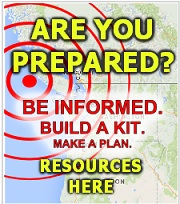Defensible Space: Protecting Your Home From Wildfire

Are You Prepared?
In Gresham, creating defensible space around your property is crucial for wildfire preparedness. Defensible space is a buffer zone around your home, typically extending 5-30 feet or more, where you manage vegetation to slow or halt the progress of fire that would otherwise engulf your property. This involves clearing flammable materials, pruning trees and shrubs, and maintaining a safe distance between plants.
Key Actions for Defensible Space:
Around the Home (0-5 feet):
Focus on creating a non-combustible zone by removing dead leaves, needles, and other debris from roofs, gutters, and eaves. Replace mulch with gravel or bare soil near the foundation.
Within 30 feet:
Prune trees, removing lower branches to prevent fire from climbing into the canopy. Ensure trees are spaced appropriately to prevent fire from spreading between them.
General Maintenance:
Regularly clear gutters, prune trees, and remove dead vegetation. Store firewood and other flammable materials at least 30 feet away from structures.
Trim branches that overhang the home, porch, and deck. Prune branches of large trees up to 6 to 10 feet from the ground.
Choose fire-resistant plants:
When landscaping, opt for native, fire-resistant species that are less likely to ignite.
Irrigation:
Keep areas near structures irrigated and moist, especially during dry periods.
Maintain Lawns:
Keep lawns mowed to a height of six inches or less.
Non-Combustible Materials:
In the immediate zone, using non-combustible materials like gravel, pavers, or concrete for landscaping can significantly reduce fire risk.
By taking these steps, you can significantly reduce the risk of your home igniting during a wildfire and improve the chances of firefighters safely defending your property.
Boosting Support for New Parents in Oregon

|
Great News For Families In Our Community! |
By Alma Landon, Wilkes East Neighbor
Oregon Senate Bill 692, which focuses on expanding access to maternal health services, has been enrolled. This bill aims to make it easier for new and expecting parents to get the support they need, including services like doula care and lactation consultations, with a special focus on making sure these services are culturally specific and competent.
As a mother and doula with Native roots, I understand how challenging it can be to find culturally specific services. That's why I'm passionate about supporting our community with knowledge and education, and I'm excited to share this important update with you all!
For more information please visit https://olis.oregonlegislature.gov/liz/2025R1/Measures/Analysis/SB692
Got Unwanted Paint? Recycle It!
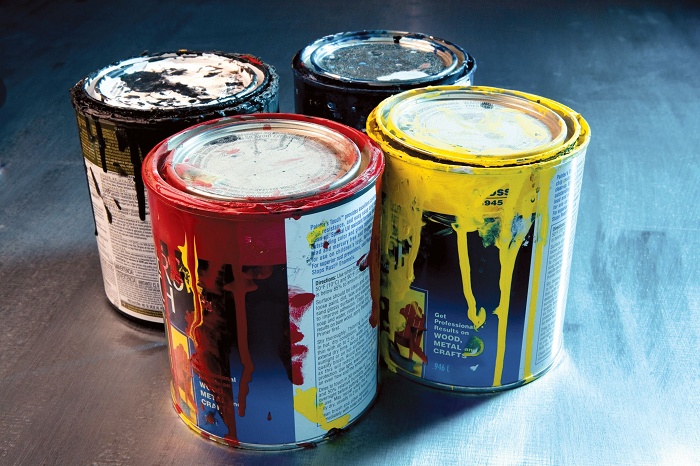
Don't Let Old Paint Cans Get In Your Way -
Recycle At These Locations!
Recycling old paint offers several benefits, including resource conservation, landfill space reduction, and potential reuse for others. It helps prevent environmental pollution from toxic chemicals and reduces the need for new paint production, saving energy and resources.
For residents of Wilkes East, the primary locations for dropping off unwanted paint for recycling is:
- Habitat for Humanity ReStore
610 NE 181st Ave
(503) 575-7336 - Sherwin-Williams
18179 NE Halsey St
(503) 666-1258
Quantity accepted varies between 20-25 gallons per visit. Both sites accept latex and oil-based house paint, stains and varnish in containers up to 5 gallons in size.
They do not accept aerosols (spray paint or other spray products), containers without original labels, or containers that are leaking or empty. Contact store for details.
For more paint recycling info visit PaintCare at https://www.paintcare.org/drop-off-sites/
Did You Know? You can toss opened and fully dry paint cans in your weekly trash.
Slider, the otter, to return to Nadaka Nature Park in 2025
But first, a group from GOPA, along with Wilkes neighborhood champion Lee Dayfield, met at Nadaka to see what might be a good fit for the park. A path of rocks resembling a meandering stream bed seemed like home for some kind of water-loving creature. And a nearby towering timber could be the perfect perch for a squawking bird. Board member, David Baumann, said he had something at home that the group might like.
A few days later, the group got together again at Nadaka to see David wheeling in a bronze otter on a hand truck! It was created by Troutdale artist Rip Caswell, and it was perfect. Then the project really got off the ground, when we met with Rip and his son, Chad, who agreed to create a life-sized Raven to perch atop the timber.
The otter and the raven were installed in the park in 2017 with help from the City of Gresham. Neighborhood families came to see the unveiling, and children entered a contest to name the creatures. That’s how the otter became “Slider” and the raven became “Seeker”. Nadaka was to be their permanent home.
Until 2024, when Slider disappeared. It seemed someone needed him more than the neighborhood did. The word went out with the hope that Slider would be returned, but not even Seeker could find him. Not giving up, GOPA President, Judy Han, met with a representative from the City to discuss how to replace Slider. Rip Caswell told GOPA he had created an additional otter, the last of his kind, and would offer it to GOPA at cost. Once again, the pieces came together to bring Slider back to Nadaka.
GOPA and the City of Gresham plan to return Slider to his meandering stream in June, 2025. We’ll provide more information on the date as it is known. Visit Gresham Outdoor Public Art’s website, www.greshamoutdoorpublicart.com, to learn more about GOPA, the project at Nadaka and other projects in Gresham.
Quirky, one-of-a-kind shops in Gresham
By Janet Unruh
Wilkes East Neighbor and Board Member
There are at least 28 quirky, one-of-a-kind shops in Gresham, including such things as yesteryear consignment shops, guitar and musical instrument shops, upscale resale women’s clothing, antiques, Mexican and Latin American flea markets; and probably others I haven’t found yet. For this article, I left out a whole category of grocers, but they include Mexican, Middle Eastern, Euro-Russian, Pacific Islander, and a little farther away: Somali, Indian, and Asian. However, I have to make an exception for the PDX Halal Supermarket and Kabul Restaurant. They sell Persian rugs, furniture, wall art, housewares, spices, and packaged foods from the Middle East. It’s right in our neighborhood at 16223 NE Glisan Street. Google reviews: Friendly people from Afghanistan! Great food with big helpings. The bread is always delicious. Great prices. Immaculately clean market. Food is authentic Afghani. Food is probably the best Afghani food that I have had in the Oregon area.
We also have a new Mexican flea market nearby called Oregon Flea Market, at 16321 SE Stark Street. Google reviews: They carry an assortment of things like candy, food, snacks, toys, gifts, shoes, clothes, jewelry, electronics, and so much more. Great place! Great vibes! There's a really awesome second-hand shop on the east end way in back of the covered area, highly recommend. Lots of cool and unusual stuff, always getting new stuff. Hidden gem!
As I was collecting the list of quirky shops, I looked at the photos for each shop in Google Maps. My eye landed on a “Fire King Jade-ite” juicer. See below.
Permit me a little diversion. Once upon a time, my family had a cabin in the Colorado mountains, which we visited every summer. We have fond memories of the scent of pine forests, evening cookouts, and the path into town. On the way to town, we’d cross streams and run through the patch of wild roses to avoid a bee sting. It was there that we had these dishes. They were inexpensive in the late 1940s, but now they are collectible.
17 Google reviewers gave it five stars. What’s extra quirky about this shop is that the owner, Carrie Hughes, runs a weekly online auction.I asked about the juicer and it had already been sold. But I was amused to find a few pieces of the green uranium glassware under a blacklight, which causes them to glow. This type of glassware is made with a small amount of uranium and is radioactive, but its radioactivity is very low. I browsed the whole place and had a good time. I was tempted to buy a blue guitar in good shape. Google reviews: Amazing hidden gem! So very great deals! My friend had to drag me out because I was about to buy half the store. Awesome place. Lots of cool stuff. Don't think I've ever been in and not come out with something. Love collecting VHS tapes from my childhood.
Here’s my list (so far) of quirky, one-of-a-kind shops:
- Amiton Furnture, 202 N Main Ave. Retail home furnishings.
- CB’s Tropical Aquarium, 3 NE 181st Ave. Fresh and saltwater fish, and accessories.
- Cheap Charlie’s Beer and Wine Superstore, 79 NE Roberts Ave. 1,000-plus brews, plus many wines.
- Deep Creek Garden Center, 2330 NE Hogan Dr. Seasonal trees, shrubs, annuals, and perennials.
- Discounts Plus, 211 NE Roberts Ave. Closeout and liquidation.
- Eagle Bargain Outlet, 867 E Powell Blvd. Eclectic furnishings, household items, clothes, etc.
- Eastside Music, 21977 SE Stark St. Musical instruments.
- “FLEA” Market, 18340 SE Stark St. Booths with lots of Mexican items, jewelry, electronics, and mini cafes.
- Found on Fremont, 560 NW Eastman Pkwy. Consignment.
- Foxtrot Vintage, 227 N Main Ave. Upscale antiques, etc.
- Gaia’s Workshop, 475 NE Burnside Rd. Drums and sacred art.
- Gresham Guitar, 835 N Main Ave. All things guitar, electric and acoustic, repairs, and lessons.
- Gresham Music, 620 SE 223rd Ave. Brass, woodwind, and stringed instruments. Orchestra, band; rentals, and lessons.
- Island Hope Mart, 17308 NE Halsey St. Pacific Islander clothing, jewelry, packaged foods, and snacks.
- JunkYard Deals Thrift Store, 23 NE 10th Dr. Upscale used furnishings and clothes.
- Let’s Play Again, 20 NW 2nd St. Toys, dolls, stuffed animals.
- La Pulga Fantastica, 19340 SE Stark St. Super-large Mexican flea market with all kinds of Mexican items and mini cafes.
- Maggie Mae’s Bookshop, 50 NW 1st St. Books, games, gifts for all ages, especially baby to teens, reading challenge, teas!
- Molly's Upscale Resale, 111 N Main Ave. Women’s clothing.
- Montavilla Sewing Center, 971 NE Kelly Ave. Sewing supplies.
- NW Creations and Collectibles, 364 NW Eastman Pkwy. Crafts. They are looking for another (cheaper) location.
- Oregon Flea Market, 16321 SE Stark St. Mexican flea market.
- PDX Halal Supermarket with Kabul Restaurant, 16223 NE Glisan St. Middle-east furnishings, grocery, and restaurant.
- Schedeen’s Nursery, 845 NE 10th St. Plants, farmer's market, gifts, and preserves; something for every season.
- Second Nature Pet Supply, 17 NW 1st St. Food, snacks, toys.
- Side Hustle Auctions and Thrift, 317 NE Roberts Ave.
- The Gresham Toy Shop, 126 N Main Ave. Toys, collectibles.
- The Other Side Nursery, 458 SE 185th Ave., #103, Rockwood Market. Wide variety of indoor plants, plus rocks and crystals.
Let’s visit these quirky shops and keep them going!
For a map showing the location of these shops, click this link.
Growing Hope: Advocating for Maternal Health
By Alma Landon, Wilkes East Resident

|
As a dedicated doula, my work is never done. I am passionate about supporting mothers and families during one of the most transformative times in their lives. I'm taking my advocacy to the state capital to present my testimony for Senate Bill 692 and Bill 693 before the Early Childhood Committee. |
This bill aims to enhance early childhood and behavioral health services, a crucial step in nurturing the next generation.
Having witnessed the profound impact that maternal mental health can have on families, I firmly believe that providing comprehensive support is essential for fostering healthy connections. Our community’s well-being starts with ensuring that mothers feel heard, supported, and equipped to thrive.
I envision a world where every mother has access to the resources and care they need, allowing them to embrace their role with confidence and joy. Together, we can create a nurturing environment for our children and help build a resilient future.
Through advocacy, education, and community engagement, we can continue to grow hope for maternal health and well-being.
A Message from Emon Ghassemi, City of Gresham, Youth Services Manager

|
Hello Gresham neighbors, I’m Emon Ghassemi, and I’m honored to serve as the Youth Services and Recreation Manager for the City of Gresham. Since joining the city in 2022, I’ve been dedicated to creating meaningful opportunities for young people and families in our community. As I approach my third year in this role, I continue to be inspired by the resilience, energy, and potential of Gresham’s youth. |
At the heart of my work is a commitment to expanding youth services, increasing access to recreation, and strengthening violence prevention efforts. One of my top priorities has been the East Multnomah Outreach Prevention Intervention (EMOPI) program, which we launched to address youth violence, provide intervention and mentorship, and connect young people with the resources they need to succeed. Through EMOPI, we’ve partnered with 18 community-based organizations to provide outreach, case management, and positive youth engagement throughout Gresham and East Multnomah County. This work is critical to ensuring that young people facing challenges have support systems in place rather than being pushed further into harm's way.
Our approach is holistic, data-driven, and deeply rooted in community collaboration. We’ve built partnerships with schools, law enforcement, behavioral health providers, and grassroots organizations to ensure that intervention efforts are preventative rather than reactive. Our goal is to interrupt cycles of violence, provide alternatives to exclusionary discipline, and create more opportunities for youth to succeed in school, work, and life. Through these efforts, we’re not only making an impact on individual lives but also strengthening the entire community by fostering safer neighborhoods, more engagement in positive activities, and greater investment in our city’s future generations.
In addition to our violence prevention efforts, I’ve been focused on revitalizing Gresham’s recreation programs to make sure families have access to safe, fun, and enriching activities. Whether it's summer camps, after-school programs, sports leagues, or citywide events, my goal is to create spaces where all young people feel included, supported, and encouraged to thrive. Recreation plays a crucial role in building connections, improving mental and physical well-being, and keeping youth engaged in positive experiences. My vision is to expand these programs so that every young person in Gresham has access to activities that inspire them and help them grow.
This March, I have the privilege of chaperoning four outstanding young leaders from Gresham to Washington, D.C. for the National League of Cities’ Congressional City Conference. Three of these youths represent the Reynolds School District. This experience will allow them to engage with elected officials, learn about public policy, and connect with youth leaders from across the country. As someone who believes deeply in the power of mentorship and civic engagement, I’m incredibly proud to support these young people as they represent Gresham on a national stage. These kinds of opportunities not only shape young minds but also empower them to become future leaders, advocates, and changemakers in their own communities.
A little about me. I was born in 1982 in Tehran, Iran, during the Iran-Iraq War, a time of great uncertainty and hardship for many families. My parents made the difficult decision to leave Iran when I was just over four years old because they wanted a better life for me and my sister, free from war and instability. We arrived in the United States and eventually made Oregon our home, where we worked hard to build a new life. Growing up as an immigrant, I experienced firsthand the challenges of adapting to a new culture, learning a new language, and trying to fit in while holding onto our heritage. Despite these challenges, I’ve always been grateful for the opportunities this country and this state have provided me.
I earned my B.A. in International Studies from Portland State University, where I developed a passion for understanding global issues, cultural dynamics, and social change. I later pursued my M.A. in Peace & Conflict Studies, which deepened my commitment to youth development, violence prevention, and creating pathways for young people to succeed. My education and life experiences have shaped my belief that every young person, regardless of their background or circumstances, deserves opportunities to thrive, learn, and contribute to their community.
Gresham has always felt like a special place to me. This city is full of passionate, hardworking people who care about their neighbors and are committed to making Gresham a great place to live. Whether I’m working with community-based organizations, collaborating with school districts, or organizing events for local families, I see firsthand the power of connection, mentorship, and community-driven solutions. I believe that when we invest in our youth, we invest in a stronger, safer, and more vibrant future for everyone. I’m proud of the work we’ve done through EMOPI, recreation, and youth outreach, and I’m excited about the opportunities ahead to expand and strengthen these efforts.
Looking forward, my focus will remain on growing these programs, deepening partnerships, and advocating for the resources our youth and families need. I welcome anyone who wants to get involved, whether you’re a parent, mentor, or community leader, because real change happens when we work together.
Thank you for letting me be a part of this incredible community. I look forward to continuing this work and seeing the positive impact we can create together!
Best,
Emon Ghassemi
Download the Wilkes East Neighborhood Spring 2025 Newsletter here!

|
Spring 2025 Newsletter"Diversity, Harmony, Community - |
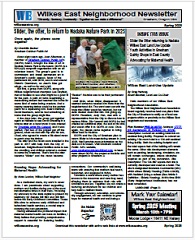
|
Spring 2025 NewsletterInside This Issue:
|
Download your copy here. (includes active web links)
¡Descargue nuestro boletín en español aquí!. (incluye enlaces web activos)
Newsletters are a regular publication of the Wilkes East Neighborhood Association. They are hand-delivered to over 1,500 residences and businesses in our area 3 times per year, timed to correspond with our general meetings.
View archive | Policy & Ad Rates
|
Got a story or tip to share? |
|
Volunteers Needed |
Download the Wilkes East Neighborhood Fall 2024 Newsletter here!

|
Fall 2024 Newsletter"Diversity, Harmony, Community - |
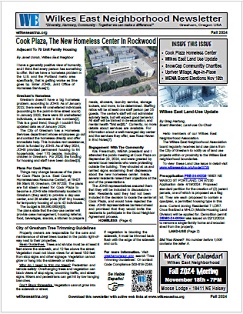
|
Fall 2024 NewsletterInside This Issue:
|
Download your copy here. (includes active web links)
¡Descargue nuestro boletín en español aquí!. (incluye enlaces web activos)
Newsletters are a regular publication of the Wilkes East Neighborhood Association. They are hand-delivered to over 1,500 residences and businesses in our area 3 times per year, timed to correspond with our general meetings.
View archive | Policy & Ad Rates
|
Got a story or tip to share? |
|
Volunteers Needed |
Cook Plaza, The New Homeless Center in Rockwood
|
Adjecent to 70 Unit Family Housing By Janet Unruh |
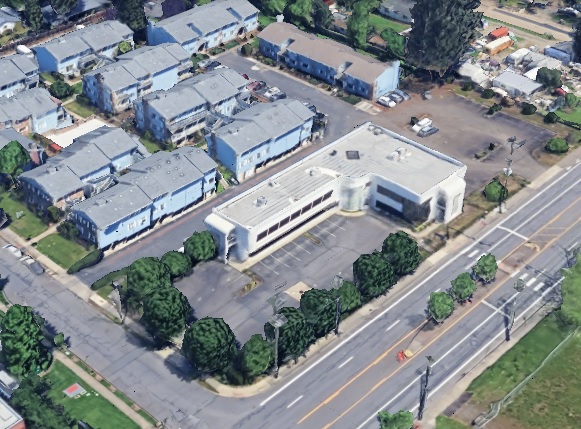 Cook Plaza, Click to enlarge |
I have a generally positive view of humanity, and I think that every person has something to offer. But we have a homeless problem in the U.S. and the Portland metro area specifically, that is getting worse as time goes by. Enter JOHS, Joint Office of Homeless Services[1].
Gresham's Homeless
Gresham doesn’t have a big homeless problem, according to JOHS. As of January 2022, there were 48 unsheltered individuals (according to the point-in-time street count). In January 2023, there were 33 unsheltered individuals, a decrease in the numbers[2]. This is a good trend, though I couldn’t find updated data as of January 2024.
The City of Gresham has a Homeless Services department whose employees go out and contact the homeless directly and offer immediate help. This includes rent assistance, which is funded by JOHS. As of May 2024, JOHS provided permanent housing to 84 households, over 170 people, including children in Gresham. For 2025, the funding for housing and staff have been doubled[3].
(If you don't see the full article below, Click "Here")
















